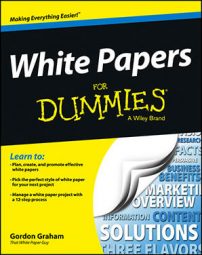A combined white paper that can work well is a problem/solution with a numbered list. The lightness of the numbered list can undercut the seriousness of the problem/solution and broaden its reach with the promise of a quick read. This mash-up can also appeal to prospects at the middle of the sales funnel, not just the top.
When to use this white paper combination
Try this mix when you want to use the appeal of a numbered list to provide a lighter take on a widespread problem and how to solve it or to reach out to prospects both at the top and in the middle of the sales funnel — and when you don’t have the time, money, or attention to do two separate white papers to achieve these goals.
Check out this example called “3 Critical Challenges on any ARRA Construction Project” that explained three common pain points that companies were experiencing with U.S. stimulus projects after the financial meltdown in 2008. The rest of the paper discussed the drawbacks of every other solution and finally described the ideal solution to this problem.
This format caught the attention of target readers, helped them understand the source of their difficulties with these projects, and proposed a solution they may never have considered: a relatively new category of software called online collaboration platforms for engineering project management.
What to include and what to leave out of your white paper
In a problem/solution–numbered list mash-up, you probably want to include a cover and perhaps a contents and copyright page as front matter. These items signify that the current white paper is somewhat more ambitious than a pure numbered list, where the front matter is more limited.
Also at the front, make sure to include a brief executive summary where you “tell them what you’re going to tell them.” Then sketch in the industry-wide problem and the drawbacks of the existing solutions as a numbered list.
For example, you can build this type of mash-up around a number of pain points caused by the problem, a set of hidden dangers every buyer must avoid, a number of benefits B2B buyers can enjoy with a better solution, or a set of questions to ask every vendor. For back matter, always include some conclusions, your call to action, and the boilerplate about the company.
In this type of combined white paper, leave out any specific product mentions and descriptions of particular features of your offering.

